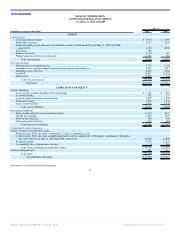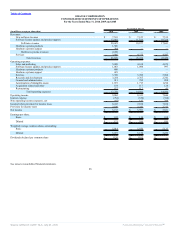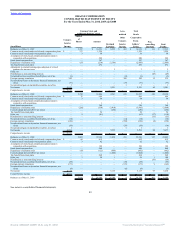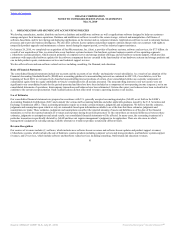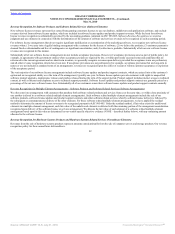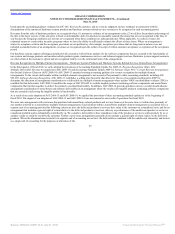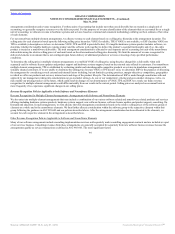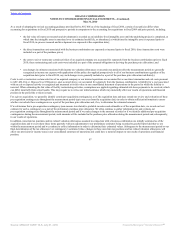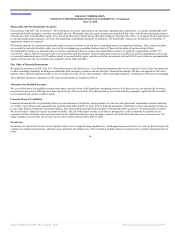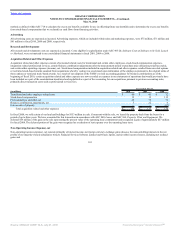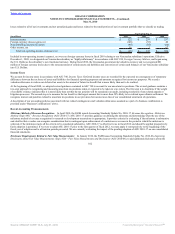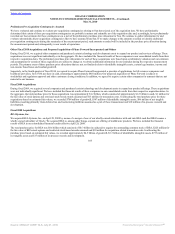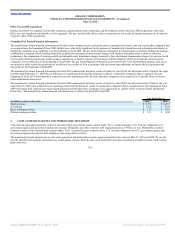Oracle 2009 Annual Report Download - page 101
Download and view the complete annual report
Please find page 101 of the 2009 Oracle annual report below. You can navigate through the pages in the report by either clicking on the pages listed below, or by using the keyword search tool below to find specific information within the annual report.
Table of Contents
ORACLE CORPORATION
NOTES TO CONSOLIDATED FINANCIAL STATEMENTS—(Continued)
May 31, 2010
As a result of adopting the revised accounting guidance provided for by ASC 805 as of the beginning of fiscal 2010, certain of our policies differ when
accounting for acquisitions in fiscal 2010 and prospective periods in comparison to the accounting for acquisitions in fiscal 2009 and prior periods, including:
• the fair value of in-process research and development is recorded as an indefinite-lived intangible asset until the underlying project is completed, at
which time the intangible asset is amortized over its estimated useful life, or abandoned, at which time the intangible asset is expensed (prior to
fiscal 2010, in-process research and development was expensed at the acquisition date);
• the direct transaction costs associated with the business combination are expensed as incurred (prior to fiscal 2010, direct transaction costs were
included as a part of the purchase price);
• the costs to exit or restructure certain activities of an acquired company are accounted for separately from the business combination (prior to fiscal
2010, these restructuring and exist costs were included as a part of the assumed obligations in deriving the purchase price allocation); and
• any changes in estimates associated with income tax valuation allowances or uncertain tax positions after the measurement period are generally
recognized as income tax expense with application of this policy also applied prospectively to all of our business combinations regardless of the
acquisition date (prior to fiscal 2010, any such changes were generally included as a part of the purchase price allocation indefinitely).
Costs to exit or restructure certain activities of an acquired company or our internal operations are accounted for as one-time termination and exit costs pursuant
to ASC 420, Exit or Disposal Cost Obligations, and, as noted above, are accounted for separately from the business combination. A liability for a cost associated
with an exit or disposal activity is recognized and measured at its fair value in our consolidated statement of operations in the period in which the liability is
incurred. When estimating the fair value of facility restructuring activities, assumptions are applied regarding estimated sub-lease payments to be received, which
can differ materially from actual results. This may require us to revise our initial estimates which may materially affect our results of operations and financial
position in the period the revision is made.
For a given acquisition, we generally identify certain pre-acquisition contingencies as of the acquisition date and may extend our review and evaluation of these
pre-acquisition contingencies throughout the measurement period (up to one year from the acquisition date) in order to obtain sufficient information to assess
whether we include these contingencies as a part of the purchase price allocation and, if so, to determine the estimated amounts.
If we determine that a pre-acquisition contingency (non-income tax related) is probable in nature and estimable as of the acquisition date, we record our best
estimate for such a contingency as a part of the preliminary purchase price allocation. We often continue to gather information for and evaluate our
pre-acquisition contingencies throughout the measurement period and if we make changes to the amounts recorded or if we identify additional pre-acquisition
contingencies during the measurement period, such amounts will be included in the purchase price allocation during the measurement period and, subsequently,
in our results of operations.
In addition, uncertain tax positions and tax related valuation allowances assumed in connection with a business combination are initially estimated as of the
acquisition date and we reevaluate these items quarterly with any adjustments to our preliminary estimates being recorded to goodwill provided that we are
within the measurement period and we continue to collect information in order to determine their estimated values. Subsequent to the measurement period or our
final determination of the tax allowance’s or contingency’s estimated value, changes to these uncertain tax positions and tax related valuation allowances will
affect our provision for income taxes in our consolidated statement of operations and could have a material impact on our results of operations and financial
position.
97
Source: ORACLE CORP, 10-K, July 01, 2010 Powered by Morningstar® Document Research℠


